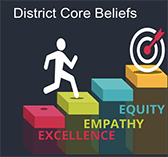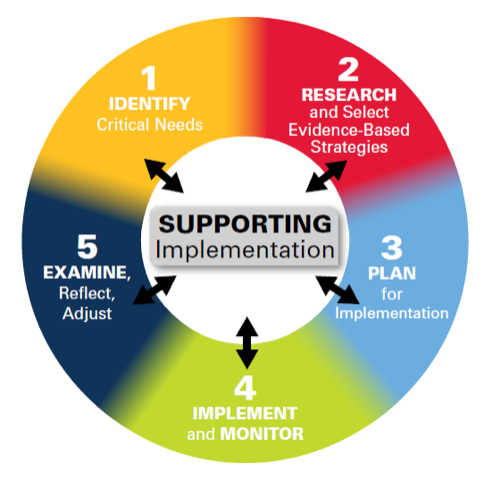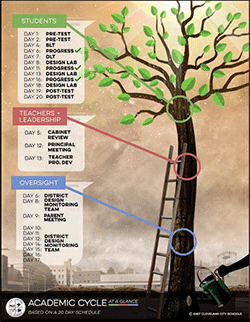Becoming a Model Urban School District: Commitment to Excellence, Empathy, and Equity Drives East Cleveland’s System-wide Improvement Efforts

East Cleveland City School District, located in Cuyahoga County, serves over 1,800 students in four elementary schools, one middle school, and one high school. Almost 100% (i.e., 99.9%) of the student population is categorized by the state as Black-non Hispanic and also as economically disadvantaged. Chronic low performance on state assessment measures resulted in East Cleveland being "taken over" by the state’s Academic Distress Commission (ADC) in September 2018. The following year, Dr. Henry Pettiegrew, II was employed as the district’s CEO and superintendent.
Prior to assuming the CEO role, Pettiegrew served as assistant superintendent in nearby Maple Heights, playing an instrumental role in improving learning outcomes for children in that district. During his interview with the East Cleveland ADC, he remarked, "we were able to improve an entire district. We thought we were defeated. But we came back and rose from the ashes and now we’re stronger than ever."

Systems Thinking: A Necessity for Meaningful Improvement
The belief that it is possible to make real improvement on behalf of all children, coupled with the understanding that sustaining improvement requires all people and all parts of the system to be engaged, characterizes Pettiegrew’s approach to leadership. He’s a systems thinker.
What does being a systems thinker really mean? Barr (2012) described systems thinking as "a set of habits or practices within a framework that is based on the belief that the component parts of a system can be best understood within the context of relationships with each other and with other systems, rather than in isolation. Systems thinking focuses on cyclical, rather than linear cause and effect, relationships." (2012, p. 1).
Pettiegrew explains it this way:
"We were coming from more than three years of not having more than an "F" on a report card, but now we’ve retooled, we’ve created a strategic plan that is in part the OIP in East Cleveland, and it has components that are different and unique. We’ve sought since February of 2019 to really build a system that’ll be responsive to the challenges instructionally to our students. And as we look at our OIP process, as a district, we've really been trying to make sure everything fit into this process, everything was completely aligned, from the strategic plan, to the action steps, making sure that everything and everyone along the way understands the why and how we're going to get things done."

Moving forward faster. Moving from being a district in distress to a district engaged in revitalization requires focus, the willingness to prioritize – to do some things well and to stop doing other things – and the ability to bring adults together around a shared purpose. In East Cleveland, the development of the district’s Road to Revitalization Plan, which details core beliefs, key commitments, and district goals, emphasizes an overarching commitment to student growth and teacher and leader capacity building.
The district core beliefs of excellence, empathy, and equity are reflected in the way Pettiegrew and other district leaders talk about their unified mission to "provide the children of East Cleveland with the academic and social-emotional preparation to succeed in the college and/or career pathway of their choice."
"There are kids with medical needs, kids with attention needs; let’s plan for their support and success, before they even walk into the room, so our lessons reflect their needs, and our assessments reflect their brilliance," said Andratesha Fritzgerald, East Cleveland’s Director of Human Resources.
"We’re looking at the academics, we’re looking at the social-emotional, and we’re looking at how these things converge to make sure students can be successful because living in an impoverished community means we have to quickly get to monetizing education and making sure that the children can make money once they’ve developed these skills, and can follow their dreams," added Pettiegrew. East Cleveland’s plan revolves around three major areas: instructional excellence, supportive environments, and community engagement. Committees are organized around each major area and faculty and staff from across the district are involved in the work of improvement.
Moving forward faster also requires a "no excuse" mindset as Tom Domzalski, East Cleveland’s Director of Data Research & Assessment/EMIS, explains:
One of the unique struggles of the district is that we are a 99% African-American district with 99% of our students qualifying for free and reduced lunch. When it comes to state or federal reporting, what is typically seen as a minority in most districts is not just our majority; it’s our student population. One of the greatest lessons we can take away from this is understanding that we have to have high expectations for our students and for our staff in the district. Saying ‘we can’t do this because…’ is not acceptable. There are high-poverty, high-performing districts across the nation and we strive to become one of those."

In charting a new course for East Cleveland, district leaders recognized the importance of actualizing the district’s commitment to teacher and leader capacity building by reassuring faculty and staff that they were learners too.
"One of the key pieces that has allowed teachers this opportunity to see that it could work, is that Dr. Pettiegrew said at the beginning of this experiment that we're all in draft form, that we don't have to have it perfect, that nobody's gonna come and get you, because, you messed up the first time, and that the expectation is, if it doesn't work, then we change it," reflected Fritzgerald.
Making the OIP work for East Cleveland. The Ohio Improvement Process (OIP) is a five-step continuous improvement process (as shown in the figure below) that rests on the use of aligned collaborative learning teams at the district, school, and classroom level. These teams provide common structures for supporting meaningful instructional discourse among educators with multiple perspectives and areas of expertise.
Initiated in 2007 and refined in 2018, the OIP works in concert with Ohio’s Leadership Development Framework (BASA, 2013) and continues to be used as the primary improvement strategy by the majority of Ohio school districts. In its early years, district internal facilitators were designated and worked alongside regional providers (i.e., state support team personnel, educational service center personnel) to support the district-wide use of the OIP as a vehicle for supporting implementation of agreed-on strategies and actions in order to improve teaching and learning.
Because Pettiegrew had served as an OIP internal facilitator, he brought extensive knowledge of OIP structures, tools, and team processes, as well as OLAC resources, to East Cleveland. He also made strategic changes in how the process was to be used in East Cleveland – changes that served to unify and focus the work across the district, engage all faculty and staff, and provide for monitoring the effectiveness of the strategies being implemented.
"Even though we have made certain instructional changes, much of the staff is the same. Many of the people are still here doing the work that they’ve always done; we’ve just created a strategic way to do it using the OIP process and some added-on components to really focus our work," explained Pettiegrew. "When you have limited resources and you have limited time, you really have to get smart about how to leverage the right resources to help children. We have a lot of different strategies to employ so we had to come up with a systematized way to prioritize," he added.
One add-on was the creation of a Design Lab, which uses a 20-day cycle of instruction – from formative assessment to end-of-cycle assessments, principals’ meetings, professional development (PD) days, parent days, and team meetings (e.g., District Leadership Team). "We found that we were having the same conversation in different rooms of the house when we really needed to be having the conversation together. So, whether you’re a child or an adult in the building, you know where you are in this 20-day calendar, which is aligned to the OIP process," said Pettiegrew. The DLT pauses every 20 days and the BLTs have a set date within the 20-day cycle when they meet to review progress toward reaching goals. TBTs meet weekly.
According to Pettiegrew, the Design Lab served to give new energy to the OIP in East Cleveland and provided a stronger foundation for developing the professional capital of the district.

"We had to find a way to take data and make it actionable, and answer the question, ‘So, what needs to change in adult implementation because of the data?’" explained Fritzgerald. "We bring teachers, administrators, related services providers together and take them through a journey. They have each other to use for collective thinking, to design instructional experiences or a unit of instructional experiences that feature agreed-on strategies, facilitate a depth of understanding of the standards, to make sure that all activities are aligned," she added.
"The work has to be engaging to pull our students in," stated Paula Elder, the district’s Director of Curriculum, Instruction & Assessment. "One of the key pieces of the Design Lab is that teachers get to design together and the support services get to work in tandem with them so that the instruction students receive is engaging but also designed to help them grow and achieve," she said.
District monitoring of adult implementation is a central OIP practice and one that East Cleveland has focused on as a way to determine "what teachers know and what they don’t know, what they struggle with, what supports are needed, and how to tailor PD to meet actual demonstrated needs," according to Fritzgerald. "Instead of running away from the data or trying to hide it or stick it in a bushel, we confront our brutal facts. Before teachers fail, how can we fortify them with PD that will protect them, that will enhance them, that gives them opportunities to practice and try safely? And, how do we build that into the system, so the system itself expects to be held accountable to the tenets that we say are important?" "It’s about system responsiveness," added Pettiegrew.
Strong core instruction for EACH child. East Cleveland has instituted a number of instructional improvement activities, including PD on teacher clarity, the use of explicit instruction, use of a reading tiered fidelity instrument (RTFI) to improve literacy instruction, and use of a multi-tier system of supports (MTSS) model. "A lot of our focus has been on middle and high school, we’ll be looking at the use of evidence-based content-area reding strategies," explained Elder who chairs the Instructional Excellence to Optimize Student Achievement Committee.
"Using the RTF revealed deficits in teachers’ understanding of both the standards and what they were really asking them to do. We wanted every teacher to understand, it’s not just about literacy teachers, but that literacy is everyone’s business," said Fritzgerald.
As a case in point, Larry Ellis, Principal of Shaw High School, has made literacy a focus so all teachers, including career tech teachers know that there are literacy standards and that they have a part in teaching reading and making sure students have the support they need," she added.

East Cleveland uses an MTSS model to identify additional supports that any student may need to be successful. "Instead of putting MTSS in a bucket, MTSS is how we live. MTSS, response to intervention (RtI), universal design for learning (UDL) exist so that wherever kids are, they get what they need. It’s really up to the adults to change our thinking around how to get kids what they need and not outsource that to some other place," said Fritzgerald.
The district is addressing the fact that about 25% of the its student population is identified as students with disabilities eligible for special education services. Rae Bastock, Director of Diversity, Equity & Inclusion for East Cleveland, views this as a result of teachers not having any other recourse for providing needed assistance to students. "Over-identification here is really a matter of teachers struggling to provide support and the system wasn’t there." She agrees with Fritzgerald: "The challenge we’re talking about is related to adult thinking, adult implementation. MTSS is the umbrella and everything operates underneath it, such as PBIS, restorative practice, and RTFI in order to provide needed support."
"We’re re-educating our staff on what it means to support students. They don’t have to be identified as special education in order for them to receive instruction that has intervention built in, and that intervention doesn’t mean a child goes someplace else. It means we restructure the environment for all students to be able to receive the instruction in the way that works for them. How does every classroom become the least restrictive environment for every student that’s in front of you?" said Fritzgerald.

"We talk a lot in the DLT of what happens when you mis-identify a student; the label, the stigma and everything that goes along with that. And lowering expectations for our kids. And that’s the worst thing you can do, especially for urban, inner-city students, is lower your expectations," offered Bastock.
Seeing Is Believing!
East Cleveland’s leadership is looking at multiple sources of data to gauge progress and asking questions like: Are students engaged? Does increased engagement affect attendance? Is the district gaining a sense of hopefulness among its students?
"The data are allowing us to articulate, within the system, where we do and don’t have tools. We talk about the concept of building toolboxes so we have an inventory of items we can go to. Previously, our toolbox consisted of a hammer and a roll of duct tape; if it didn’t work with duct tape, we used more duct tape. We’re engaged in a paradigm shift in the district and a significant one," explained Domzalski. "We’re not just asking, ‘did you pass the test or not?’ We’re using the 20-day process and the OIP structure to make decisions for students and adults based on the data and then re-evaluating. These aren’t singular data points; they’re layered," he added.
Changing a system is hard work and there are no perfect systems. But, in East Cleveland, the intentional and aligned actions being put in place by Pettiegrew and his team are taking hold.
Principal Ellis reflects on the change process under way in East Cleveland:
"From a building perspective, not only does it sound good, but you can hear the conversation changing around the building to be more about students and what we do to improve outcomes. Staff are focused when they go to Design Lab. And, now we’re at a place where because we begin to see positive outcomes, we begin to believe more and more that we can achieve to the highest if we just give this an opportunity to work. The benefits of all these pieces are beginning to take effect. The teachers began to get away from compliance because they had a voice and they began to take more risks. As a system, we have more and more buy-in, and therefore we’re seeing more and more productivity, which is going to lead to better academic achievement."
East Cleveland has several key partners – used strategically by district leadership. State Support Team Region 3 has been and continues to be a major support for the district. Additionally, Harvard University’s Proving Ground initiative, a partnership with Johns Hopkins University and the Ohio Department of Education, and the Cleveland Browns have supported improvement efforts in the district.
When asked where he wants East Cleveland to be in five years, Pettiegrew responds, "we’ll be the model urban school district in the state and eventually the nation. You’ll see a district that is flexible and transformative, that’s really responsive to students and that uses a different way of making decisions based on what students need. You’ll see a different way of buildings functioning and different ways of students interacting with the curriculum – remote and in-person. We want to be in a leading position to help other districts with populations of students like ours so each child can achieve their dreams."
Resources
Barr, S. L. (2012). State education agencies: The critical role of SEAs in facilitating school district capacity to improve learning and achievement for students with disabilities. Minneapolis, MN: University of Minnesota National Center on Educational Outcomes. Retrievable from http://www.movingyournumbers.org/images/resources/81554-sea-guide.pdf
For More Information
For more information about the East Cleveland City Schools and its efforts to reform the district and improve outcomes for all children, contact Andratesha Fritzgerald at afritzgerald@eastclevelandschools.org. Visit East Cleveland’s YouTube channel at Cardinals Nation.
For more information about resources to support districts during the pandemic and beyond, contact Dr. Jim Gay, OLAC Co-director, at jimgay@basa-ohio.org; or Karel Oxley, OLAC Co-director, at Oxley@basa-ohio.org.